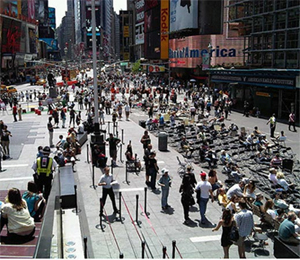In those humble, semi-comical lawn chairs that are newly strewn across Broadway at the intersection of Times Square, you are witnessing the future of New York City and, indeed, the future of the city itself as a human institution.
As of last week, the Bloomberg administration made good on its promise to close Broadway down, at least provisionally, from 42nd to 47th streets (and also from 33rd to 35th streets). In part the pilot project is intended to relieve congestion by redirecting vehicular traffic to Sixth and Seventh avenues. (The mayor has yet to decide whether the pedestrian mall will be permanent.)
But more vitally, it is a recognition of how cities are evolving on our post-industrial planet. For the first time in history, urban-ness has become its own reward. People come to cities not for their careers, but for the sheer pleasure of urban experience. And though it is well known that New York was the first city to enter the modern age, it is no less true that it is the first city to have entered the post-industrial age.
In fact, New York can fairly claim to be the laboratory and the template of how the world (whose population is becoming ever more urban) may soon look and feel. Even as the recent economic downturn has made us, for the moment, a more sober and practical species than we were 12 months ago, we collectively have more leisure activities and more options than ever before. With tele-conferencing and the pervasiveness of the Internet, there is, ostensibly, less reason than ever for a place like New York to exist.
Why then is it still so populated by tourists and people looking to move here?

Times Square (Source: ratherbebiking on Flickr)
Because it is being progressively reborn as a center of recreation, a playground city where urban spectacle and human density can be seen alongside parks and cultural amenities. Post-industrial technologies uncannily reproduce almost any visual or auditory experience short of the main thing — that of actually being there. But New York City represents the one, irreplaceable “there.”
In this connection, certain developments around New York City begin to make a new kind of sense. Consider the former centers of the city’s industrial base: Soho with its factories, the Meatpacking District with its abattoirs, the waterfront along the Hudson and East rivers that once teamed with longshoremen and stevedores.
With almost formulaic regularity, each has been transformed by high-end restaurants, boutiques and residential developments. When the Highline, that rusting mile of deserted train tracks on the Far West Side, reopens as a park later this month, it will stand as an emblem of the way in which a piece of urban infrastructure, and then a symbol of urban decay, has become a monument to a city’s resurrection.
For now, as New York citizens and tourists lounge around in deckchairs on the alien asphalt in Times Square, the “crossroads of the world,” they are experiencing the thrilling incongruity of recreational urban-ness, a relatively new emotion in a pavement city, and one that will soon come to define it.
James Gardner, formerly the architecture critic of the New York Sun, writes on the visual arts for several publications.